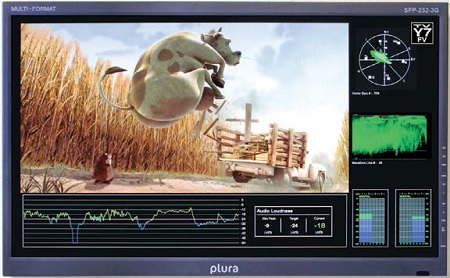WLVT Simplifies Monitoring With Plura
BETHLEHEM, PA.—Today’s technologies, including 2K, 4K, HD and other formats, require fairly complex monitoring to ensure standards compliance and subjective acceptance by distribution networks. With monitors from Plura Broadcast, which offers monitors for both field and post-production, I have found a relatively new “standard of quality.”

SEP-224 monitor features loudness monitoring, waveform, vector and audio bar graph displays.INSIDE & OUT
Every production team wants the flexibility of using the same family of monitors in the field as well as in post to ensure image consistency. When a tool like the Plura SFP-224-3G-24-inch comes along, it simplifies everyone’s job. I can’t say enough of Plura’s ability to reproduce images consistently across various display platforms; including Plura 9-inch and 17-inch monitors in the field and 24-inch in the edit suite.
We use either the 9-inch or 17-inch monitor on every field shoot for our weekly magazine show “Focus.” WLVT-TV’s “Focus” generally offers two or three local segments wrapped with a studio sequence. The Plura monitors are used to view both playback and camera video; single or flypack shoots. This enables correlation of the image quality to that seen on the 24-inch monitor in the edit suites.
When the videographer can rely on a monitor to set up lighting and cameras in the field, and both the production/editing and engineering teams agree on the value of the same monitoring product, the director of engineering’s job becomes fun. There is nothing more detrimental to a team than a broadcast operations staff arguing subjective aspects of content.
The fact that Plura’s user interface allows morphing the monitor from “production mode” to “engineering mode” with a single button press is phenomenal. The Plura engineering display includes CALM certificate loudness monitoring, waveform, vector, audio bar graph displays and the ability to monitor the 16 embedded audio signals, making it one of the most useful monitors that I have ever used. (For the record, I have literally seen and used hundreds.) With physical interfaces to RGB, YPbPr, Composite, SDI, fiber (via SFP) HDMI and so on, Plura monitors are at home in any broadcast television or production environment.
TEST & MEASUREMENT FEATURES
I’ve seen many companies add a variety of test displays with low-quality to monitors, resulting in the user purchasing features that aren’t of much use. In general, today’s waveform monitor is used mainly to ensure proper exposure, black level, and gamma. Many video attributes can be corrected in post, however, getting the camera exposure correct goes a long way in reducing the amount of time spent correcting the images later.
Plura monitors have a great quality of rasterization, ensuring very usable waveforms, while also offering the ability to present SDI data in a textual format. This can help with things like start of active video, which is important image data that many operators don’t concern themselves with as much as things like whether or not the camera is operating properly.
The first day I showed a Plura monitor to my production team, they literally would not give it back. They had been waiting for something lightweight and battery- operated, offering features of the most expensive monitors. Unsurpassed quality, simple operation and flexibility; that’s all they’ve ever asked for, and with Plura it’s finally in the house.
Dave Guerrero is chief operating officer for WLVT-TV. A member of SMPTE, AES, SBE and IEEE, Guerrero brings over thirty years of broadcast experience as the leader of the engineering team at WLVTTV, PBS39. He can be reached atDavidG@wlvt.org.
For more information, visitwww.plura.tvor call 602-944-1044.
Get the TV Tech Newsletter
The professional video industry's #1 source for news, trends and product and tech information. Sign up below.
